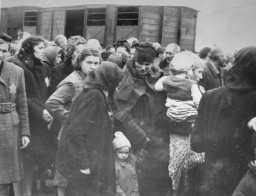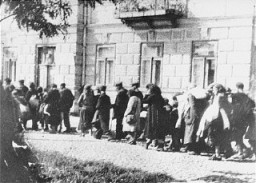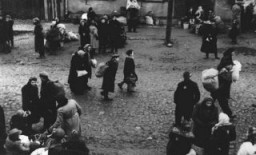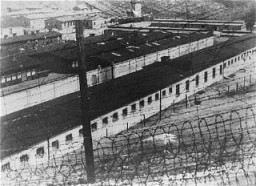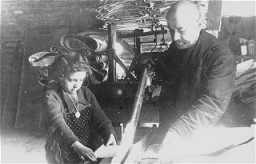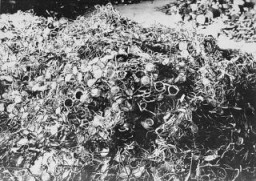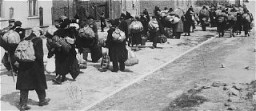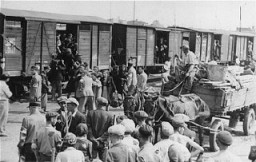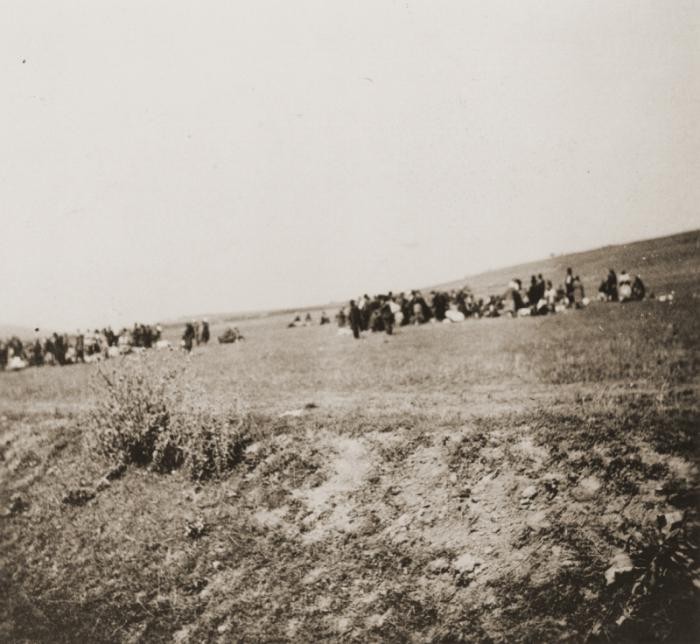
Mass Shootings of Jews during the Holocaust
In the summer of 1941, following Germany's attack on the Soviet Union, Germans began to perpetrate mass shootings of Jewish men, women, and children in territory seized from Soviet forces. These murders were part of the “Final Solution to the Jewish Question,” the mass murder of Europe’s Jews.
-
1
The Nazi German regime perpetrated mass shootings of civilians on an unprecedented scale.
-
2
Mass shooting actions were often conducted in broad daylight and in full view and earshot of local residents in occupied eastern Europe.
-
3
Almost one third of the six million Holocaust victims were murdered in mass shootings.
Nazi Germany and its allies and collaborators perpetrated mass shootings of Jews in territory seized from Soviet forces. This is sometimes known as the Holocaust by bullets. As many as 2 million Jews were murdered in these mass shootings and associated massacres.
In 1939–1940, after Germany and the Soviet Union partitioned Poland, the Soviets annexed the Baltic states and regions of prewar Poland and Romania that had large Jewish populations. After the German invasion of the Soviet Union in June 1941 (known as Operation Barbarossa), the Germans and their allies and collaborators carried out thousands of mass shooting actions in the territories they seized from Soviet forces. As German forces moved quickly across eastern Europe, they conducted mass shootings in small towns such as Ejszyszki (Eishyshok), moderately sized cities such as Kamenets-Podolsk, and large cities such as Kyiv (Kiev). The civilian administrations that Germany and its allies established in the seized territories concentrated the remaining Jews in ghettos and continued to murder them periodically in mass shootings.
Much of Holocaust remembrance and research focuses on the role that ghettos, concentration camps, and killing centers played in the Holocaust. Less attention has been paid to the key role that mass shootings played in the murder of the Holocaust’s six million victims.
The Start and Escalation of Mass Shootings, Summer 1941
In June 1941, Nazi Germany invaded the Soviet Union. German military and police authorities were instructed to wage a “war of annihilation” (Vernichtungskrieg) against Nazi Germany’s alleged racial and ideological enemies. These supposed enemies included Communists, Jews, Roma, and other Soviet civilians.
Almost immediately after the invasion, German SS and police units began to carry out mass shootings of local Jews. At first, these units targeted Jewish men of military age. But by August 1941, they had started massacring entire Jewish communities, regardless of age or gender. This marked a radical escalation in Nazi anti-Jewish policy that ultimately culminated in the “Final Solution to the Jewish Question”—the Nazi plan to murder all of Europe’s Jews.
Many different types of German units perpetrated mass shootings in the territories seized from Soviet forces. The most infamous are the Einsatzgruppen (special task forces of the Security Police and SD). However, the Einsatzgruppen only had 3,000 personnel who had a wide variety of tasks and were deployed directly behind the entire eastern front. Other German units including Order Police battalions, Waffen-SS units, and German military (Wehrmacht) units also perpetrated numerous massacres. Their manpower was essential to carrying out the Holocaust by bullets.
Furthermore, German units were not the only ones who carried out mass shootings. In many places, they relied upon the manpower of local auxiliary units working with the SS and police. These auxiliary units were made up of local civilian, military, and police officials. In addition, forces of Romania, Germany’s ally, carried out mass shootings of Jews in territory they seized and controlled.
Killing Process
While mass shootings did not always follow the exact same process, they tended to be perpetrated in a similar fashion. The usual first step in a mass shooting (referred to in German as an Aktion) was for German units and local collaborators to round up the Jewish residents of a village, town, or city. They would then take the Jewish residents to a predetermined location in the outskirts. Next, they would force them to dig a mass grave or take them to mass graves prepared in advance. Finally, the Germans and/or local collaborators would shoot all of the men, women, and children into these pits.
In some places, shooters employed a strategy known irreverently as Sardinenpackung (“sardine packing”) in which the victims were forced to lie on the ground and were then shot in the back of the neck and skull. Dirt was scattered thinly over the newly dead and the next victims were instructed to lie atop them, where they too were shot. The victims often had to watch their loved ones die before them.
Mass shootings frequently occurred in broad daylight and in full view and earshot of local residents.
After the massacres, the Germans deliberately tried to hide these mass graves. Most remained unmarked for decades and many remain unmarked to this day. An unknown number of mass graves remain undiscovered and unidentified throughout eastern Europe.
Gas Vans as an Alternate Form of Mass Killing
The mass shootings were resource-intensive, requiring many shooters and escort guards, as well as guns, ammunition, and transport. Concerns about the inefficiency of the shootings and their psychological impact on the shooters led to the development of special vans outfitted with hoses that pumped carbon monoxide from the van engine’s exhaust into sealed back passenger compartments. Jews were packed into the compartments, then driven to a mass grave, asphyxiating during the journey.
The vans had difficulty navigating rough roads in inclement weather, however, and they required fuel and parts that were in short supply. It also took much longer to kill very large groups of victims with the gas vans. Furthermore, the German personnel disliked having to remove the victims’ bodies and clean the compartments. Throughout the German occupation of seized Soviet territories, mass shootings continued to be the preferred method of murdering Jews.
Large-Scale Massacres in 1941
The Germans and their allies and collaborators perpetrated mass shooting actions that sometimes claimed the lives of hundreds or thousands of victims, and at other times claimed the lives of even tens of thousands. Generally, the large-scale massacres are better known. This is because of the high number of victims, and the fact that the large-scale mass shootings were perpetrated close to bigger towns or cities. The perpetrators were unable to keep these murderous events secret and hidden from the local populations.
Among the largest mass shootings conducted in the first months of Operation Barbarossa were the massacres at Kamenets-Podolsk and Babyn Yar (Babi Yar).
Kamenets-Podolsk
On August 26-28, 1941, German SS and police units, supported by Ukranian auxiliaries, murdered 23,600 Jews at Kamenets-Podolsk (Kamianets-Podils’kyi) in occupied Ukraine. The victims included local Jews, as well Jews who had been deported from Hungarian territory to German-occupied territory.
Babyn Yar
On September 29-30, 1941, SS and German police units and their auxiliaries murdered a large portion of the Jewish population who remained in Kyiv at Babyn Yar (Babi Yar). At the time, Babyn Yar was a ravine located just outside the city. According to Einsatzgruppen reports, 33,771 Jews were massacred during this two-day period. After the massacre, the ravine at Babyn Yar became a killing site where Germans murdered tens of thousands of people, mostly non-Jews, between 1941 and 1943. It is estimated that some 100,000 people were murdered at Babyn Yar.
Killing Sites: Places of Multiple Massacres
 Near some cities in territories seized from the Soviets, the Germans established killing sites where they repeatedly carried out massacres. Tens of thousands of people, most of them Jews, were murdered at each of these killing sites. The most infamous of these sites are:
Near some cities in territories seized from the Soviets, the Germans established killing sites where they repeatedly carried out massacres. Tens of thousands of people, most of them Jews, were murdered at each of these killing sites. The most infamous of these sites are:
- Fort IX in Kovno (Kaunas)
- the Rumbula and Bikernieki Forests in Riga
- Ponary near Vilna (Vilnius)
- Maly Trostenets near Minsk
At these killing sites, Germans and local collaborators murdered tens of thousands of local Jews. They also deported tens of thousands of German, Austrian, and Czech Jews from central Europe to these killing sites in 1941 and 1942.
Operation Harvest Festival
The largest mass shooting operation of the Holocaust did not take place in territories seized from the Soviets. Rather, it took place in the General Government (Generalgouvernement; part of German-occupied Poland that Germany did not annex). The Germans called this mass shooting action Operation Harvest Festival (Erntefest). The goal of Operation Harvest Festival was to murder the Jews remaining in the General Government. These shootings took place on November 3–4, 1943, at the Lublin/Majdanek concentration camp and the Trawniki and Poniatowa forced-labor camps. German SS and police units rounded up the Jewish prisoners from these and several other camps and shot them in pits dug for this purpose.
This two-day operation claimed the lives of some 42,000 Jews. It brought to a close Operation Reinhard, the German plan to murder the approximately two million Jews living in the General Government.
Number of People Murdered in Mass Shootings
It is impossible to determine the exact number of Holocaust victims killed in mass shootings, as the Germans did not keep an exact count and destroyed nearly all reports on the shootings before the war ended.
Based on the few available wartime reports and on demographic studies of prewar and postwar Jewish populations, it is estimated that the Germans and their allies and collaborators murdered as many as 2 million Jews in mass shootings or gas vans in territory seized from Soviet forces.
